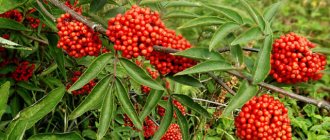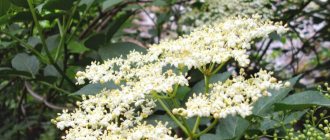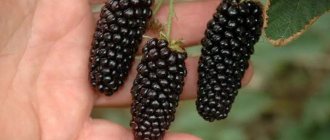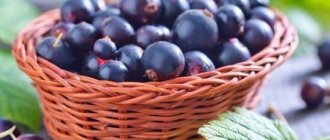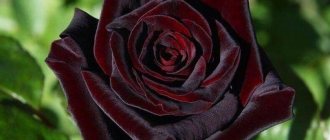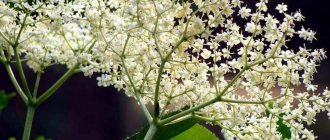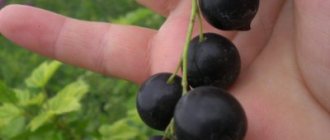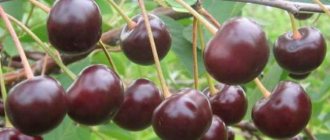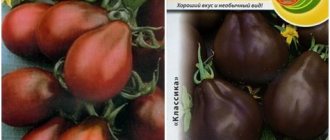Advantages and disadvantages, differences from other varieties
It cannot be said that all reviews about the variety fit into the interjection “Ah!”, but both amateurs and professionals note many positive qualities of the Black Beauty. This, for example, is the versatility of using fruits, as well as:
- high productivity;
- compactness of the plant;
- good presentation of fruits, their transportability;
- excellent taste of any cooked dishes, without bitterness;
- ease of care;
- high disease resistance;
- adaptability to changing weather conditions;
- a small amount of seeds.
The following are most often indicated as relative disadvantages:
- the impossibility of growing in the middle zone without greenhouses;
- strong dependence of yield on the level of agricultural technology;
- high demands on illumination.
However, few well-known varieties are free from these disadvantages. Thus, there are not very many varieties for unprotected soil that can be grown without problems in cool climate regions. Although, for example, the hybrid King of the North is successfully grown without greenhouses even in Siberia, reviews about its taste are very contradictory. The Negus variety is very good in such a situation, but its fruits are rated only as good in taste. The quality of Esaul eggplant fruits is highly valued, but its yield is lower.
In terms of the shape of the fruit, this variety is somewhat reminiscent of the Albatross eggplant, zoned in the Lower Volga region, but Albatross ripens somewhat earlier, and its resistance to diseases is worse. The pear-shaped fruits of the Vera variety are ready for harvest even earlier, but it cannot boast of yield. However, the comparison can be continued endlessly: if there were an ideal variety, others would not be needed.
Advantages and disadvantages of the plant
The elderberry of this variety has a pronounced dignity, which is characterized by its appearance. This plant is easy to distinguish from others. Among other advantages I would like to note:
- fits perfectly into any landscape ideas, delimits shrubs and dilutes deciduous structures;
- does not require special care skills and is unpretentious;
- tolerates cold well and requires shelter only at temperatures below -35 degrees;
- consistently produces fruit for decades;
- has good immunity to diseases and pests;
- tolerates polluted air and drought well;
- the fruits can be used in pharmacology, cosmetology and cooking.
The Elderberry variety Black Beauty can easily tolerate any soil. The only thing that is important for the plant is that the soil is constantly moist. In addition, this shrub grows well even in a shaded place. In order to develop normally, Elderberry must receive light only in the first half of the day and this is quite enough for her. The description of this variety also has its drawbacks. Experienced gardeners consider annual pruning to be one of these disadvantages. In this process, it is difficult to select the two-year-old branches of the bottom row. It is simply necessary to do such pruning so that the plant continues to grow and develop normally.
Planting and caring for black elderberry Black Beauty
The elderberry variety is planted in spring or autumn. Two-year-old layerings are considered good planting material. For planting, choose shaded areas on the north side. Experienced gardeners advise planting shrubs so that they are not exposed to strong winds.
The Black Beauty elderberry variety is capable of growing as a single-trunked, medium-sized tree, but gardeners and designers prefer to form a shrub from several central shoots.
Seedlings for planting are selected based on their appearance. They should be intact, have light brown bark, and have several strong branches.
The place for elderberry is prepared several weeks before planting. The soil is dug up and fertilized with organic complexes. Then the ground is covered with plastic wrap for several days. This helps normalize the acidity level of the soil: soil with a pH of 6 to 6.5 is suitable for elderberry.
The seedling is placed in the prepared hole, fertilized with potassium-phosphorus complexes, covered with soil, compacted, and watered. When planning to grow elderberry in 1 trunk, after planting, install a support and tie up the seedling.
Blue elderberry
Blue elder Sambucus cerulea photo
A fairly tall tree, often about 15 m, is an inhabitant of the floodplains and mountain slopes of North America. There is also a shrub form with thin branches and young shoots of a crimson hue. The trunk of the tree and bush is yellowish-beige, and the leaves have a bluish tint. The leaf consists of 5-7 bare long leaflets 6-15 cm in length.
The flowers are small, white with a yellow or beige tint, collected in inflorescences up to 15 cm, and have a characteristic aroma. In September the fruits ripen - blue-black berries, half a centimeter in diameter. Blue elderberries have a bluish tinge on them that makes them appear really blue. Prefers warmer latitudes, as it is not frost-resistant.
Siberian elderberry
Siberian red elderberry photo
This subspecies of red elderberry is more resistant to frost, therefore it grows in Siberia, the East, and European Russia. Favorite places are mixed or coniferous forests and highlands. Siberian elderberry is a lush shrub up to 4 m in height. It is also called red elderberry for the color of the berries, which, by the way, ripen in late July - early August. The berries are edible when ripe, but are not popular. But unripe fruits cause abdominal pain, nausea, cramps, headaches, and can even lead to death.
Elderberry care
Elderberry in spring
In March, trees and shrubs may suffer from sunburn - the bark becomes very hot under the bright spring sun, and at night there is a sharp cooling. To prevent the consequences of this phenomenon, the trunks and forks of the skeletal branches of elderberry are covered with a layer of lime. If damage caused by rodents in winter is found on the bark, disinfect it with a strong solution of potassium permanganate and cover it with garden varnish.
On warm, fine days, you can start pruning the elderberry, and after that treat the bush with a solution of Nitrafen or Bordeaux mixture against diseases and pests that managed to overwinter in the bark or soil under the bushes and trees. The tree trunk circles are freed from insulating material and last year's leaves. If the winter was snowless and the spring was dry, carry out moisture-recharging watering of the elderberry.
Caring for elderberries in summer
After elderberry blooms, the bush is sprayed against pests and powdery mildew.
At the beginning of summer, plants begin to actively grow and form ovaries, so the most important task is to provide the garden with moisture and nutrition. The soil in tree trunk circles must be kept loose and moist. In bushes that are frozen in winter, root growth begins to grow, which must be immediately destroyed before it outstrips the bush itself. To prevent the elderberry from spreading throughout the garden, you can dig old slate around the bush at a distance of one and a half meters and to a depth of half a meter.
In August, elderberries are already beginning to ripen on some bushes, and you should be ready to harvest. At the end of summer, it is necessary to create conditions to prepare the bushes for wintering: a rainy summer can cause secondary growth of shoots, which can only be stopped by removing the mulch from under the bushes and pinching the tops of the growing shoots.
How to care for elderberry in the fall
Caring for elderberries in the fall is preparing them for winter. In September, the elderberry harvest continues, after which sanitary pruning of the bush is carried out. At the end of the month, they dig up the soil in the tree trunk circles, apply fertilizers, and, in dry autumn conditions, carry out pre-winter watering of elderberries. If you are just planning to plant elderberries, dig holes for the seedlings at the end of September and fill them with fertilizers.
In October, the bushes are treated from pathogenic microorganisms and pests that have settled for the winter in the bark of branches or in the soil under the bush, and trunks and large branches, in order to protect them from winter rodents and spring burns, are whitened with freshly slaked lime or chalk with the addition of copper sulfate and carpentry glue. Tree trunk circles are insulated with peat, humus or dry leaves.
As soon as the snow falls, throw it under the bush - this will be the best protection for the elderberry from frost.
Elderberry processing
Twice a year - in early spring, before buds open, and after leaf fall - elderberry bushes and the soil under them are treated for preventive purposes with a one percent solution of Bordeaux mixture or a two to three percent solution of Nitrafen. They do this in order to destroy fungal infections or harmful insects hidden for the winter in the bark or in the top layer of soil.
Instead of these drugs, you can use a one percent solution of copper sulfate or another drug of similar effect. A seven percent urea solution, if treated with it in the spring, acts not only as a fungicide and insecticide, but also as a nitrogen supplement needed by the plant at this time of year.
Watering elderberry
Rainy summers and mulch around the tree trunk, which does not allow moisture to quickly evaporate, can save you from watering elderberries. It is best to mulch the soil around the elderberry bush with compost or rotted manure. In summer with normal rainfall, you will not need to water the elderberry, but in dry, hot times, pour 10-15 liters of water under the elderberry bush once a week. Young plants are watered more often. Do not let the soil under the bushes dry out. After watering or rain, it is very convenient to loosen the soil around the bushes and remove weeds.
Feeding elderberry
In fertile soil, elderberry grows well without fertilizing, but it responds very well to nitrogen fertilizers applied in spring and summer to poor soil. Of the organic fertilizers, elderberry is best accepted by slurry and chicken manure infusion. She is also favorable to urea and complex mineral fertilizers. In autumn, elderberries are not fed.
Description of elderberry
Black elderberry in landscape design photo What black elderberry looks like
Elderberry, most often a bush or low tree, ranges from 2 to 10 m in height. The genus also includes herbaceous plants, for example, “herbaceous elderberry”. However, we will pay more attention to black elderberry, as the most sought-after representative of the elderberry genus.
Black elderberry is a perennial woody plant. The branches are dense and thin. Young stems are green in color, but as they mature, they acquire a characteristic gray color and are covered with small “scales.” The leaves consist of an unpaired number of long serrated leaflets; the total leaf length can reach up to 30 cm.
Elderberry blooms at the end of May. Large, more than 20 cm in diameter, flat shields of inflorescences consist of white or light beige flowers of 0.8 cm each. The aroma of elderberry blossoms is strong, slightly suffocating up close. At the end of summer, the fruits ripen - a cluster of black berries with seeds. The berries themselves are small, less than a centimeter. Inside there is reddish pulp.
Elderberry is a fast-growing plant, and also very useful, so attention will be paid here not only to its planting, care and formation, but also to its beneficial properties, as well as situations when it can be dangerous.
Characteristics of the variety
According to reviews from landscape designers, the crown of the Black Beauty elderberry can take various forms. The shrub is used to structure the composition of the garden; it is planted next to trees with bright green leaves to increase the contrast between them. Due to its ease of maintenance, black elderberry is recommended for growing in gardens and summer cottages.
Winter hardiness of black elderberry Black Beauty
The frost resistance of elderberry is above average. The shrub is able to tolerate sub-zero temperatures without loss. When reaching – 30 – 35 °C, Black Beauty elderberry is covered with industrial material. For this, agrofibre or polyethylene film is used. A good protection against cold weather is to cover the soil around the bushes.
Despite efforts, many young shoots may freeze. In the spring, after processing and removal of additional material, most of them are able to recover.
Productivity and fruiting
Black elderberries are a round, dark purple fruit. The pulp of the fruit becomes juicy when ripe. From 2 to 4 seeds are formed in the center.
Elderberry fruiting begins in the 3rd year of its existence. The berries begin to ripen in September. The taste of the fruit is sweet and sour, astringent. Up to 2–3 kg of berries are harvested from one bush.
If for some reason the fruits remain on the bushes until frost, they do not fall off or dry out. After freezing, elder drupes become food for birds remaining for the winter.
Important! Black elderberry fruits are harvested when fully ripe. Unripe berries contain toxic substances that can cause poisoning
Area of application of fruits
The fruits of the black elderberry variety Black Beauty are used in different ways:
- for making wines and homemade alcoholic tinctures;
- as a main ingredient for jams and preserves;
- as a filling for pies and butter cookies;
- for the preparation of extracts in the pharmaceutical industry;
- as an ingredient in home cosmetology recipes;
- for the preparation of external use in folk medicine due to the properties possessed by tannins.
Berries contain essential oils, beneficial acids and organic compounds that have a beneficial effect on all systems of the human body when properly prepared.
The fruits are harvested when fully ripe from mid-September - by cutting off the whole bunches. The berries are not stored for long - 8 - 10 days in the refrigerator, and therefore they are used for processing.
Resistance to diseases and pests
The variety is highly resistant to diseases and pests. Measures to combat the appearance of powdery mildew, gray rot or the proliferation of aphids are considered to be timely prevention. It includes:
- treatment with fungicides before spring flowering;
- mulching the soil during the summer;
- timely loosening of the soil after rains and heavy watering.
Advantages and disadvantages of the variety
Black Beauty elderberry has obvious advantages; due to its unusual appearance, it is easy to recognize in the photo and cannot be confused with other varieties.
Advantages of the Black Beauty elderberry variety:
- suitable for any landscape designs: dilutes any deciduous ensembles, can be used to delimit areas;
- unpretentiousness: does not require special care;
- frost resistance: needs shelter only at temperatures below –35 °C;
- stable fruiting: for several decades;
- resistance to infections and pests;
- ability to tolerate drought and air pollution;
- use in pharmacology of both fruits and flowers and leaves.
The Black Beauty elderberry variety is particularly characterized by its ability to adapt to a variety of soils. The only necessary condition for adaptation is to ensure moderate soil moisture. In addition, this variety of shrubs can grow in a shaded area. To develop, it needs to receive sunlight in the first half of the day.
The description of the Black Beauty elderberry variety also indicates its disadvantages. Gardeners consider annual pruning to be one of the disadvantages. The complexity of the procedure lies in the selection of two-year branches of the lower row. This is necessary for further growth and formation of the bush.
For novice gardeners, the procedure for propagating varieties can be difficult. Cuttings are carried out under strict adherence to temperature and air humidity levels. Layers are kept in greenhouses before planting. They are planted in open ground in the 2nd year of existence, after full rooting and formation of leaves.
Beneficial properties of black elderberry
Since ancient times, black elderberry has been considered a medicinal plant, but the berries were rarely consumed for table purposes, considering them dangerous. Due to the abundant presence of hydrocyanic acid in the leaves and berries of elderberry, consumption in excessive quantities can be destructive, therefore, only ripe black elderberry berries are suitable for consumption and are often used only for medicinal purposes.
Homeopaths and herbalists use crushed black elderberry raw materials for brewing and obtaining healing mixtures and infusions.
Black elderberries are used for gastrointestinal disorders, gallbladder diseases, as an antibacterial and choleretic agent, in the fight against urolithiasis, urinary tract diseases, acute respiratory viral infections and acute respiratory infections. Decoctions of elderberry leaves have antiseptic and anti-inflammatory effects. Elderberry bark decoction treats gout and skin diseases.
Black elderberry leaves are included in kidney preparations and help in the treatment of cystitis and urethritis.
Without a doubt, black elderberry is a very useful plant, but treatment should only be carried out under the supervision of an experienced homeopath, since there is a risk of complications when using elderberry, in addition, black and red elderberry berries are easily confused, and the use of the latter will lead to death.
Elderberry rhizomes contain quite a lot of saponins, and when used judiciously, the prepared decoction has an expectorant and thinning effect (therefore, it is indispensable for diseases of the upper respiratory tract).
In addition, plant materials also have a sedative effect, normalizing the condition after nervous breakdowns.
The carotene content in the inflorescences allows infusions and decoctions of black elderberry flowers to have an antioxidant and tonic effect on the body.
The fruits of black elderberry and their moderate consumption increase immunity and create a powerful anti-inflammatory barrier in the body. Anthocyanins and tyrosine contained in the juice of black elderberries stimulate the production of melanin in the body.
The bark and foliage of black elderberry has a hemostatic and wound-healing effect when brewed.
Elderberry can become a guardian of garden plants; thanks to its phytoncidal properties, the bush repels pests. Elderberry branches contain essential oils, acids and resins that have a laxative effect for constipation.
In Rus', elderberry tincture reduced pigment spots and got rid of scars, and girls wiped their faces with elderberry decoction to preserve youth.
Growing
Eggplants are very heat-loving plants, more heat-loving than tomatoes and peppers. Therefore, the main feature is that the plants grow well and bear fruit in warm and humid conditions:
- The optimal temperature required for the rapid emergence of seedlings (after 10-12 days) is at least 20-25 degrees, and for the development and growth of the plant - 25-30 degrees. Temperature changes and freezing are detrimental to eggplants.
- It is necessary to control the watering of plants; if there is a lack of moisture, the flowers and ovaries fall off, and the fruits do not ripen. Excessive watering promotes the development of diseases.
- Eggplants like to grow in chernozem soil or light loam.
- Do not forget about timely fertilizing with organic and nitrogen fertilizers.
Growing eggplant seedlings
The Black Beauty variety of eggplant is grown in seedlings; in warm regions it is possible to grow the vegetable by sowing in open ground.
The best predecessors are carrots, melons and legumes.
Eggplant seedlings tolerate transplantation very poorly. Eggplant seeds are sown in special pots measuring from 7x7 to 9x9 cm or in a nursery. The pots are filled with homemade or store-bought nutrient soil.
Prepare the soil yourself in a ratio of 6:1:4, where, respectively:
To 10 liters of the prepared mixture add 20 g of phosphorus, 10 g of nitrogen and 5 g of potassium fertilizers.
You can also use the following methods to improve the yield:
- To increase germination before sowing, seeds are soaked for 2-3 hours in a growth stimulator (Ecosil, Emistim, Acrobat MC). You can use the old proven method: soak the seeds in water for 2-3 days until they germinate.
- Make 4-5 holes 2 cm deep in a pot and place one seed in them, sprinkle with soil and water generously with warm water.
- Seeds are sown in the ground 50-70 days before planting seedlings.
- After the seedlings emerge, one of the most developed plants is left in the pot.
Expert opinion Filatov Ivan Yurievich, private farmer for more than 30 years
The first feeding is carried out after the formation of 2 leaves on the plant, and the second after two weeks. To prepare the fertilizer, 100 g of superphosphate, 50 g of ammonium nitrate and 30 g of potassium salt are diluted in 10 liters of water. The prepared solution is enough to treat a nursery with an area of 3 m2.
Seedlings are hardened 20-25 days before planting in a permanent place, growing conditions are brought closer to natural ones.
Seedlings are transplanted into a greenhouse or open ground if they have:
- 7-9 true leaves,
- developed root system,
- stem 5-7 mm thick
- height of at least 10 cm.
Seedless cultivation of eggplants
In warm regions, eggplants can be grown without seedlings, by sowing seeds in open ground.
In a well-warmed, fertilized area of the garden, rows are made with row spacing of 60-70 cm or two strips of rows with a distance of 30-40 cm between them, and 70-80 cm between strips.
Is it important to plant eggplant seedlings in sun-warmed soil?
Not really
Holes 2-3 cm deep are developed in the rows and sprouted seeds are dropped into them. Gently sprinkle with soil and water generously. The soil temperature during and after planting should be at least 15 degrees.
After germination, the plants are broken through, leaving a distance of 25-30 cm between the bushes.
Reproduction methods
Black elderberry reproduces in two ways: seed and vegetative. As the latter, the method of rooting cuttings or layering can be used.
Using seeds
Growing a bush from a seed is quite difficult; in addition, in this case it is not always possible to achieve preservation of varietal characteristics. Nevertheless, this option is possible. To do this, freshly picked fruits should be placed in a warm place until the pulp begins to rot, then the seeds should be removed, soaked for several hours in a growth stimulator (Epin, Kornevin, etc.) and immediately sown in a pot filled with moistened water. a mixture of fertile soil and sand.
Read about the uses of black elderberry flowers.
It is recommended to cover the planting container with film to create a greenhouse effect. When the seeds sprout, the film is removed, if necessary, the sprouts are transplanted into separate pots, and when the plants reach a height of 50 cm (in no less than a year), they are planted in open ground.
Video: propagation of elderberry by seeds
By cuttings
It is much easier to propagate Black Beauty by cuttings. It is best to cut cuttings when the plant is dormant (late autumn or very early spring), although you can also use the material that was obtained at the time of the next cutting.
Did you know? Some peoples have an interesting belief: if you put three elderberries in a man’s pocket, he will resist the charms of any temptress. Therefore, the bush is considered a symbol of family preservation, a talisman of the hearth.
For rooting, cuttings up to 25 cm long are taken with at least two healthy buds on each. There is no need to root elderberries in water. The cuttings are immediately buried in a moist mixture of fertile soil with sand and peat. A sign that the seedling has taken root is the appearance of young shoots and leaves on it.
If the cuttings were pruned in the fall, in the spring, as a rule, the rooted plants can be transplanted to a permanent place.
Using bends
The easiest way to propagate elderberries is through layering (or offsets). The essence of the method is that in the spring, a healthy branch is selected from the base of an adult bush, bent to the ground (it must first be dug up and loosened well), pinned approximately in the center and sprinkled with fertile soil at the attachment point.
Did you know? Many Slavic peoples believed that an evil spirit, an evil spirit, lived under the elderberry tree, so they were afraid to cut down the bush.
Then it is important to water the cuttings regularly and abundantly until they form their own root system. Usually by autumn the young bush is ready for replanting; it must be carefully separated from the mother plant, dug up along with a lump of earth and planted in a permanent place.
Landing
The site for planting shrubs should be selected based on the future size of the adult plant. It is better to place the elderberry in the sun or in light partial shade, in an area protected from strong winds. In order for the plant to delight with lush flowering and berries, the soil must be nutritious; for a hedge, you can plant a bush on depleted soils. Elderberry does not like acidic and damp soils. The hole for the seedling should be slightly larger than its root system. When planting, you should add 50 g of phosphorus and potassium fertilizers and a bucket of humus.
We recommend that you read the description of black elderberry variety Black Beauty.
The sequence of further actions is as follows:
- Pour a layer of fertile mixture onto the bottom of the hole.
- Place the seedling in the middle of the hole and cover with the rest of the soil.
- Gently compact the soil around the trunk, making sure that the root collar remains above the soil level.
- Water the elderberry and mulch the tree trunk with peat, sawdust or bark.
Both spring and autumn are suitable for planting, and container seedlings can be planted in summer. It is advisable to carry out autumn planting 1–1.5 months before frost, so that rooting has time to occur.
Elderberry herbaceous
Sambucus ebulus photo
This is a perennial herbaceous plant with erect stems reaching a height of 1.5 m. People call it wild elderberry or stinking elderberry, for the pungent smell of the flowers. In the wild, she is an inhabitant of forests, forest edges, floodplains, and mountain slopes of Central Russia, Ukraine, and Belarus. The leaves are located on long petioles and consist of 9-11 narrow serrated leaflets. The flowers are collected in inflorescences, erect, white or pinkish in color.
The fruits of the elderberry are black shiny drupes, very attractive in appearance and easily accessible to children. You have to be careful, because all parts of elderberry are poisonous (contain hydrocyanic acid). Some literature describes the use of these berries for making liqueurs and other alcoholic drinks, but this is a controversial issue. Now, if you plant currant grass with elderberry, it will repel harmful butterflies and bud mites. But there is a minus - this plant has a strong creeping stem, so it will be problematic to remove elderberries from currants. When the flowers are dried, the unpleasant smell disappears and they are sprinkled onto apples for storage.
Care
The main elements of caring for black elderberry are:
- watering;
- feeding;
- trimmings;
- weeding and loosening
The plant is not very demanding of moisture and can grow in conditions of short-term drought, but in dry summers it cannot be done without watering. One bucket of water under the bush will be enough for a week of hydration. It is better to fertilize in early spring. The introduction of nitrogen promotes the active growth of vegetative mass. The plant is most responsive to urea. Solid fertilizers are embedded in the soil to a depth of 10-12 cm, liquid fertilizers are applied with watering.
“For organic matter, you can use solid manure, compost or an infusion of bird droppings.”
Elderberry pruning is carried out in order to give the plant the desired shape, its rejuvenation and healing. Formative pruning can be carried out at any time during the growing season. In the spring, pruning is needed to remove frozen and winter-damaged branches. The same procedure can be carried out in the fall.
The largest number of fruiting ovaries is formed on 2-3 year old branches; over time, their number decreases, and by the age of six they stop bearing fruit altogether. Therefore, it is recommended to remove old elderberry branches. Once every three years, for the purpose of rejuvenation, the above-ground part is cut off so that only 10-centimeter stumps remain, which are covered with garden pitch. Over the summer, new shoots grow, and the bush is transformed.
Weeding and loosening of the tree trunk circle is favorable for the development of elderberry. To prevent the reappearance of weeds, as well as to maintain optimal soil moisture for a long time, mulching is an excellent technique. For these purposes, you can use dry grass, chopped bark or sawdust.
Elderberry Siebold
Elderberry Siebold Sambucus sieboldiana photo
An eastern relative of the red elderberry. Natural halo - Japan, Kuril Islands, Far East. In Europe, a cultivated form is grown - a powerful plant (tree or bush) up to 8 m high with large leaves (20x6 cm). The inflorescences are loose, racemose, large.
Use in landscape design
The decorative qualities of Black Tower elderberry are manifested in pronounced color accents. Greening cities, municipal buildings, private houses. They decorate parks, slopes, front gardens and flower beds, strengthen slopes and ravines. Looks gorgeous surrounded by shrubs of golden and green color. It especially stands out against the background of the contrasting row among the yellow compact barberries and spherical coniferous plants in the foreground. If you follow all the rules of planting and care, the elderberry grows a lush crown with pink flowers. It blooms for many years and pleases the eye with its beauty in any landscape composition.
Elderberry downy
Elderberry downy photo
It got its name due to the fact that the young shoots are pubescent. North America is considered its homeland. Cultivated varieties - four-meter shrub. It blooms in May, the color of the inflorescences is white, sometimes with a yellow tint, sometimes with pink. The fruits are red berries with seeds and ripen in July.
You can note forms with different fruit colors:
- xanthocarpa – yellow-orange fruits;
- leucocarpa - white fruits.
How to plant?
First you need to find a suitable place to plant elderberries. Experienced gardeners recommend giving preference to loamy soils with sufficient moisture parameters. It happens that the soil on the site is acidic. These are not the best conditions. Such land must be prepared in a year or two by liming it. Experts also say that a month before planting elderberries, you need to properly prepare the soil.
It is important to remove all weeds. It will not be superfluous to apply mineral fertilizers, which will have a beneficial effect on the growth rate of elderberry
There are often situations when no fertilizing or additives are added to the soil, but the elderberry grew very quickly and reached a good size. This situation indicates that the plant is undemanding to the soil. However, it is still not recommended to leave the soil without useful components. Having chosen a place, you can proceed to planting elderberries. It is recommended to plant a plant that is already 2 or 3 years old - then it will take root more quickly. It is advisable to plant elderberry in the northern or eastern corners of the house plot or garden. For good pollination, this crop should be planted near other plants.
Elderberry should be planted during warm periods. It may be autumn, but you should not choose too cold days. First you need to prepare holes, the depth of which will correspond to the length of the elderberry rhizomes. For each specific case, the parameters will be different. Fertilizers mixed with soil should be placed in the hole. Bushes should be buried right up to the root collars. It will be useful to use boles, which are ordinary stakes firmly fixed in the ground. As soon as the elderberry planting is completed, you need to water it
Until the plant takes root in its new location, it is important to keep the soil moisture level in its surroundings under control.
Caring for Black Beauty lily at home
OT hybrids are not picky plants, so caring for them will not take much time and effort from the gardener. The main thing is to follow a few simple recommendations for choosing a site for lilies, to properly water and feed the plant so that it can delight its owners with lush color and delicate aroma.
Lighting, temperature and humidity
Lily flowers love warmth and feel great under the scorching sun. Their appearance does not deteriorate, and the color does not fade from exposure to UV rays, which cannot be said about the plant stem. The powerful stem of lilies prefers to be in the shade, which is worth considering when choosing a planting site.
All types of lilies do not tolerate wind well, so it is better not to plant them in too open areas.
High humidity is detrimental to the bulbs; under constant exposure to water, they begin to rot and the plant dies. Draining the area using river sand and crushed stone will help cope with excess moisture. Giant lilies are characterized by increased frost resistance and can withstand temperatures down to -35 degrees.
Watering, fertilizing, soil care
Lilies require a responsible approach to watering. The plant does not like excess moisture, but watering is still necessary, especially during dry periods.
It is better to feed lilies in several stages. Experienced gardeners recommend fertilizing 3 times a year:
- After winter, during the appearance of shoots. This will allow the plant to regain strength and energy after wintering. Complex mineral fertilizers, such as Agricola, are ideal for the first feeding.
- During the period of bud formation for better flowering. In such cases, a potassium sulfate solution is suitable.
- During the period of active flowering. You can use humus (compost, chicken manure), but not fresh.
Regular feeding will allow the plant to replenish the energy spent on flowering. The soil on which the flowers were planted requires periodic loosening. In this way, you can not only get rid of weeds, but also enrich the soil with oxygen. Also, the soil must be mulched using natural components of a light shade (mown grass, hay, sawdust). This is necessary in order to protect the bulb from overheating, which can stop all biological processes.
Preparing for winter
Despite its frost resistance, the OT hybrid needs to be helped to survive the winter. To do this, the stem, which serves as a conductor of cold air, is completely cut off. This not only minimizes the flow of cold to the bulb, but also reduces energy consumption due to the fact that there is no need to maintain the viability of the stem. It is recommended to sprinkle the area with lilies with dark bark.
It will also be interesting: Lily Pretty Woman - description and care at home?
Aftercare
Further care of the shrub includes seasonal pruning. It is carried out twice:
- spring, crown-forming pruning according to a special pattern with trimming the lower branches, removing the tops, cutting out damaged branches;
- autumn, sanitary pruning - in order to get rid of damage, dead wood and correct the formation of the crown.
When the elderberry begins to bloom and form fruits, it needs abundant watering. The weekly volume of water is 2-3 buckets per bush.
Fertilizers are applied at the root, following the step-by-step steps:
- Spring fertilizer - nitrogen-containing complexes.
- Summer feeding - with potassium and phosphorus.
- Autumn fertilizer - organic.
To retain moisture, protect against weeds and growth, the agrotechnical method of mulching is used. The soil around the bush is covered with a layer of straw, chopped bark or sawdust.
Mulching, left for the winter, also helps protect the bush from rodents, which often attack fruit crops. Elderberry is no exception, so gardeners protect the bushes using available methods. List of defense techniques:
- whitewashing the main trunk with lime;
- installation of nets and fences;
- spraying toxic mixtures.
For wintering in regions with low temperatures, elderberries are covered in advance, before frost sets in. The bush is protected with breathable material, bending the branches to the ground. A good option for shelter from frost is tying with pine branches. This method is suitable for small young bushes.
Planting and care
For planting, it is recommended to use one to two year old seedlings. The optimal time for planting is spring or autumn. The plant is not picky and grows in any area, but to obtain more luxuriant flowering it is better to use well-lit areas.
As for the soil, the most suitable for black elderberry is loam or a pod-golden, slightly acidic substrate. If the acidity levels are excessively high, then dolomite flour should be added to the soil before planting, but this should be done first, at least six months before the upcoming planting.
Important! During flowering, Black Lace and Black Beauty elderberries emit a specific aroma that repels insects. For this reason, plants are often planted near concentrations of flies and other insects. A month before the upcoming planting, you should prepare a hole measuring 80*50 cm
A peg is dug into the middle, which at first will serve as a support for the elderberry seedling. The dug up soil is mixed with rotted humus, phosphorus and potassium
A month before the upcoming planting, you should prepare a hole measuring 80*50 cm. A peg is dug into the middle, which will initially serve as a support for the elderberry seedling. The dug up soil is mixed with rotted humus, phosphorus and potassium
Part of the mixture is evenly distributed along the bottom of the pit
When the time for planting approaches, the soil at the bottom of the hole is loosened and the seedling is carefully placed there. The elderberry root system is carefully straightened
The plant is covered with the rest of the fertile mixture. It is important that the root collar is located above ground level. The final stage is to compact the earth and fill it with plenty of water.
Elderberry in a pot
The black elderberry Black Beauty is unpretentious in care, but needs regular watering. One of the features of care is that the bush needs to be treated with lime, because direct sunlight leaves burns on the plant.
It is worth noting that it is not at all necessary to fertilize the soil around the Black Beauty elderberry; it grows well as is. But the plant will respond well to the application of mineral and organic fertilizers, producing larger flowers.
To give an adult semi-shrub an attractive appearance, it must undergo sanitary pruning annually. Remove branches that are damaged, dry, or infested with various pests.
Black elderberry berries Black Beauty are unsuitable for consumption; they are poisonous and can cause severe poisoning.
Black elderberry Black Beauty is a shrub plant belonging to a separate family of the genus Adoxaceae called Elderberry. In nature, there are more than forty varieties of this species, one of their representatives: elderberry aurea. Scientists from Holland developed it in 2000. Poorly studied shrub species were taken as donors.
Gradually, elderberry was brought to the USA and Russia. European agronomists grow it in parks and forests, as well as for landscaping residential areas. Our gardeners do not use this bush as an ornamental plant; they mainly plant it to produce berries.
Planting elderberry
To plant elderberry, you need to dig a small planting hole, half a meter deep and 45 cm wide is enough. In order for the bush to develop quickly, the excavated soil should be mixed with peat and superphosphate during planting, and rotted organic matter can be added if desired.
If the plant is intended to be grown as a tree, then a peg should be driven into the planting hole to further support the tree during the process of growth and development.
If you do not want the overgrown elderberry to turn into annoying shoots and fill the garden, then you should dig slate around the perimeter of the hole for the seedling (at a distance of about 60 cm).
A bucket of water is poured into the planting hole and part of the soil substrate mixed with fertilizers is added (depending on the length of the seedling, this can be half or a third of the soil mixture).
Holding the elderberry seedling slightly above the base, press it tightly to the soil and cover it with the remaining soil. After planting, the soil is compacted and watered abundantly.
Breeding and planting Black Beauty lilies
Breeding and replanting this variety does not require special equipment or extensive experience.
It is important to take into account several rules so that the plant takes root and grows healthy without loss of immunity.
Reproduction by daughter bulbs
Propagation using daughter bulbs is the most popular, as it requires the least time due to the absence of the need to grow planting material. For this method, it is enough in the fall, after the plant has flowered, to slightly dig up the bulb and separate small bulbs from it with your hands, which are then planted in the prepared soil.
Daughter bulbs
Children
Once every 4-5 years, small bulbs, no more than 1 cm in diameter, appear on the basal part of the stem. They are called the children of the plant. These bulbs can also be used for propagation. To do this, you need to separate the largest and healthiest children from the stem and allow them to get stronger and grow in a home pot before planting in an open area.
Scales
Reproduction by scales is a popular, but rather difficult method of reproduction. To do this, no more than 2/3 of the scales are collected from healthy and large bulbs. The collected material is first kept at a temperature of 22-24 degrees, later the temperature in the room with the scales should drop to 18°C.
Scales from a lily bulb
A month before planting, the scales must be placed in a cool, dry place. The ideal option would be the bottom shelf of the refrigerator. Immediately before planting, the scales are thoroughly washed under running water and soaked in a solution of potassium permanganate.
Elderberry
Canadian elderberry is close to black elderberry. Originally from North America, it has large feathery leaves, yellowish-white flowers, fragrant, small, collected in large (up to 30 cm in diameter) umbrellas. The fruits are spherical, dark purple, shiny, about 5 mm in diameter, edible. The shoots are bare at first green, then dark purple, slightly ribbed, with numerous lentils.
The Canadian elderberry has many decorative garden forms with different dissection and coloring of the leaves, with different fruits, even red ones. The most common form is acutifolia with heavily dissected leaves. It freezes slightly every year, but blooms and bears fruit.
In cultivation, all types of elderberry are usually propagated by seeds, sowing them in the fall. For sowing in spring, long-term stratification is required (4 months). 1000 pieces of red elderberry seeds weigh 2.5 g, and black elderberry - 3.3 g. Canadian elderberry forms root suckers. Decorative forms of elderberry, when grown from seeds, partially retain the characteristics of the mother plant. They can also be propagated by woody cuttings.
This is what Canadian elderberry looks like
Did you know that the distinctive feature of this shrub is not only the decorative effect of the plants themselves and its many forms?
Many gardeners have long noticed that there are no plant pests around the red elderberry, and they try to give this shrub a place on the site, propagating it with seeds, layering, and cuttings. When growing elderberries, keep in mind that the inflorescences and bark contain valeric acid, which explains the love of cats for it, gnawing the bark and often feasting on the flowers of this beautiful and healthy shrub. When growing elderberry, keep in mind that the inflorescences and bark contain valeric acid, which explains the love of cats for it, gnawing the bark and often feasting on the flowers of this beautiful and healthy shrub
When growing elderberries, keep in mind that the inflorescences and bark contain valeric acid, which explains the love of cats for it, gnawing the bark and often feasting on the flowers of this beautiful and healthy shrub.
Photo of elderberry
Red elderberry looks especially beautiful in September and October, attracting attention with large clusters of bright scarlet berries. This deciduous shrub can sometimes grow as a small tree. It is distributed throughout Eurasia and North America, where it is found both in the wild and in cultivated forms as an ornamental foliage plant in parks and gardens.
Elderberry is often used for urban greening
It is distributed throughout Eurasia and North America, where it is found both in the wild and in cultivated forms as an ornamental foliage plant in parks and gardens. Elderberry is often used for urban greening.
Plant height can vary from 1.5 to 3 m depending on the region of growth and weather conditions.
External characteristics:
- straight, highly branched stems with rough bark with a white dot;
- leaves with a jagged edge of an oblong shape of a rich dark emerald color, while young leaves can be purple;
- snow-white flowers, collected in large inflorescences, with a specific smell;
- The fruits are scarlet in color and have an unpleasant taste.
The plant is not used in official medicine, so there are no serious laboratory tests of its composition.
